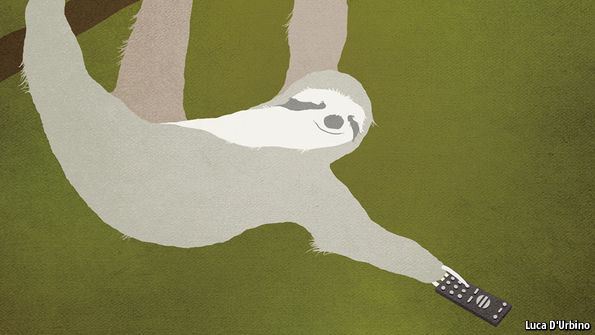Winner takes all: A slow-motion revolution: Traditional TV’s surprising staying power
Winner takes all: A slow-motion revolution
Traditional TV’s surprising staying power
from The Economist
You have to wait until a certain hour on a certain day on a certain channel to watch TV. TV is terrifyingly antiquated
People will be able to pick any show at any time from just a few favourite platforms like Netflix or Amazon as well as Facebook and Snapchat
But all this is happening in slow motion, because both distributors and networks have a deeply vested interest in retaining it
Broadcast television is being eroded: 1) billions of people are now watching free videos on SNS supported by targeted advertising
2) Subscription services are amassing big user bases with a low subscription & investing heavily in content, which is strangling a cable TV
In the late C20, the number of channels of cable TV increased as media companies discovered serving niche audiences could generate revenues
Yet as media companies kept adding channels, pay TV hit the limit of the number of channels an average consumer can see in a week: 17
In US the typical pay-TV bill has doubled in a decade, to more than $100 a month, which created an opportunity for internet video providers
US’s viewing of broadcast & cable TV by all age groups fell by 11% & aged 12-24 40% in past 6 yrs. The market penetration: 90% (2010) to 80%
Cord-cutting is beginning in developed markets like US and will damage the cabe TV companies enjoying gross profit margins of 30-60%
Somewhat ironically, TV is now at it’s best because networks (e.g. HBO and FX) and streaming services are competing for subscribers
This competition has given viewers shows that cost $10m an episode and has caused Netflix to pay huge for a third season of Black Mirror
Not everyone will be a winner. Last year 450 original shows were available on US’s TV, more than twice as many as 6 yrs earlier
The $109bn acquisition of Tme Warner would give AT&T vertical integration to protect it if and when the current pay-TV system crumbles
Sports programmes, the last stronghold of the pay-TV oligopoly, accounted for 93 of the 100 broadcasts in 2015, compared with 14 in 2005
Advertising rates in general have been flat or declining in most of the industry, but spending on ads for sports has risen by 50% 2005-2015
The cost of sports rights has been rising. Annually, ESPN is paying $5.5bnr for NFL. ESPN and TNT are paying $24bn for NBA
Investors are asking how long this can go on. ESPN lost millions of subscribers in recent years. The escalating fees will put them off more
For mobile devices streaming rights are sold separately. Telecom companies are likely to offer increasingly large fees to stream sports
The existing business model remains too lucrative to abandon. But eventually fans will watch sports on screens in alternative realities.

